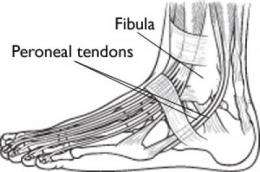Chronic ankle pain may be more than just a sprain

Ankle sprains are a common injury after a fall, sudden twist or blow to the ankle joint. Approximately 40 percent of those who suffer an ankle sprain will experience chronic ankle pain, even after being treated for their initial injury.
A review article published in the May 2009 issue of the Journal of the American Academy of Orthopaedic Surgeons (JAAOS) explains that tendon injuries to the ankle can be a possible cause for this chronic pain. In some cases, the condition is untreated or overlooked which prolongs the pain and the problem.
"When patients injure their ankles, the injury may not seem serious at first," explains Terrence Philbin, DO, lead author of the article and Fellowship Director of the Orthopedic Foot and Ankle Center in Columbus, Ohio. "People may not seek medical attention and they can think it will just get better on its own. I think that is why this condition often goes undiagnosed."
The authors of the article describe how in some cases chronic ankle pain may actually be the result of injuries to the peroneal tendons.
- The peroneal tendons are located behind the outside portion of the anklebone (called the fibula). The tendons help to stabilize the foot and ankle.
- Tendon injuries can include tendonitis or swelling around the tendons. In more severe cases, the peroneal tendons can actually tear or there can be a swelling of the tendons behind the fibula bone. This can cause the ligament that holds the tendons together to stretch out and tear, or even rupture.
- Ankle pain that is not responding to treatment
- Swelling and tenderness around the outside of the ankle
- Pain behind the anklebone
- Pain that transmits from the ankle down into the foot
If the condition is caught early, non-operative treatment options can include:
- Rest, ice and elevation
- Anti-inflammatory medication
- Immobilization in a cast or brace
- Physical therapy
Peroneal tendon injuries can happen suddenly or can develop over time. The injury is most common among athletes involved in sports that require repetitive ankle motion and in individuals who have high arches of the foot.
A proper diagnosis is essential in order to treat peroneal tendon injuries correctly and to help alleviate chronic pain. Philbin reminds patients, "If you have ankle pain and it is not getting better, do not ignore it. Get it evaluated by a physician who has experience treating foot and ankle injuries."
Source: American Academy of Orthopaedic Surgeons (news : web)
















